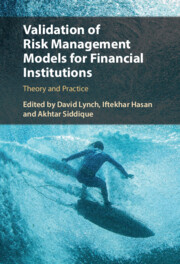Book contents
- Validation of Risk Management Models for Financial Institutions
- Validation of Risk Management Models for Financial Institutions
- Copyright page
- Contents
- Figures
- Tables
- Contributors
- Foreword
- Acknowledgments
- 1 Common Elements in Validation of Risk Models Used in Financial Institutions
- 2 Validating Bank Holding Companies’ Value-at-Risk Models for Market Risk
- 3 A Conditional Testing Approach for Value-at-Risk Model Performance Evaluation
- 4 Beyond Exceedance-Based Backtesting of Value-at-Risk Models: Methods for Backtesting the Entire Forecasting Distribution Using Probability Integral Transform
- 5 Evaluation of Value-at-Risk Models: An Empirical Likelihood Approach
- 6 Evaluating Banks’ Value-at-Risk Models during the COVID-19 Crisis
- 7 Performance Monitoring for Supervisory Stress-Testing Models
- 8 Counterparty Credit Risk
- 9 Validation of Retail Credit Risk Models
- 10 Issues in the Validation of Wholesale Credit Risk Models
- 11 Case Studies in Wholesale Risk Model Validation
- 12 Validation of Models Used by Banks to Estimate Their Allowance for Loan and Lease Losses
- 13 Operational Risk
- 14 Statistical Decisioning Tools for Model Risk Management
- 15 Validation of Risk Aggregation in Economic Capital Models
- 16 Model Validation of Interest Rate Risk (Banking Book) Models
- 17 Validation of Risk Management Models in Investment Management
- Index
- References
10 - Issues in the Validation of Wholesale Credit Risk Models
Published online by Cambridge University Press: 02 March 2023
- Validation of Risk Management Models for Financial Institutions
- Validation of Risk Management Models for Financial Institutions
- Copyright page
- Contents
- Figures
- Tables
- Contributors
- Foreword
- Acknowledgments
- 1 Common Elements in Validation of Risk Models Used in Financial Institutions
- 2 Validating Bank Holding Companies’ Value-at-Risk Models for Market Risk
- 3 A Conditional Testing Approach for Value-at-Risk Model Performance Evaluation
- 4 Beyond Exceedance-Based Backtesting of Value-at-Risk Models: Methods for Backtesting the Entire Forecasting Distribution Using Probability Integral Transform
- 5 Evaluation of Value-at-Risk Models: An Empirical Likelihood Approach
- 6 Evaluating Banks’ Value-at-Risk Models during the COVID-19 Crisis
- 7 Performance Monitoring for Supervisory Stress-Testing Models
- 8 Counterparty Credit Risk
- 9 Validation of Retail Credit Risk Models
- 10 Issues in the Validation of Wholesale Credit Risk Models
- 11 Case Studies in Wholesale Risk Model Validation
- 12 Validation of Models Used by Banks to Estimate Their Allowance for Loan and Lease Losses
- 13 Operational Risk
- 14 Statistical Decisioning Tools for Model Risk Management
- 15 Validation of Risk Aggregation in Economic Capital Models
- 16 Model Validation of Interest Rate Risk (Banking Book) Models
- 17 Validation of Risk Management Models in Investment Management
- Index
- References
Summary
This chapter examines wholesale credit risk models and their validation at US banking institutions. The most common practice in wholesale credit risk modeling for loss estimation among large US banking institutions today is to use expected loss models, typically at the loan level. The chapter discusses the quantification and validation of three key risk parameters in this modeling approach, namely, probability of default (PD), loss given default (LGD), and exposure at default (EAD).
Keywords
- Type
- Chapter
- Information
- Validation of Risk Management Models for Financial InstitutionsTheory and Practice, pp. 232 - 262Publisher: Cambridge University PressPrint publication year: 2023



